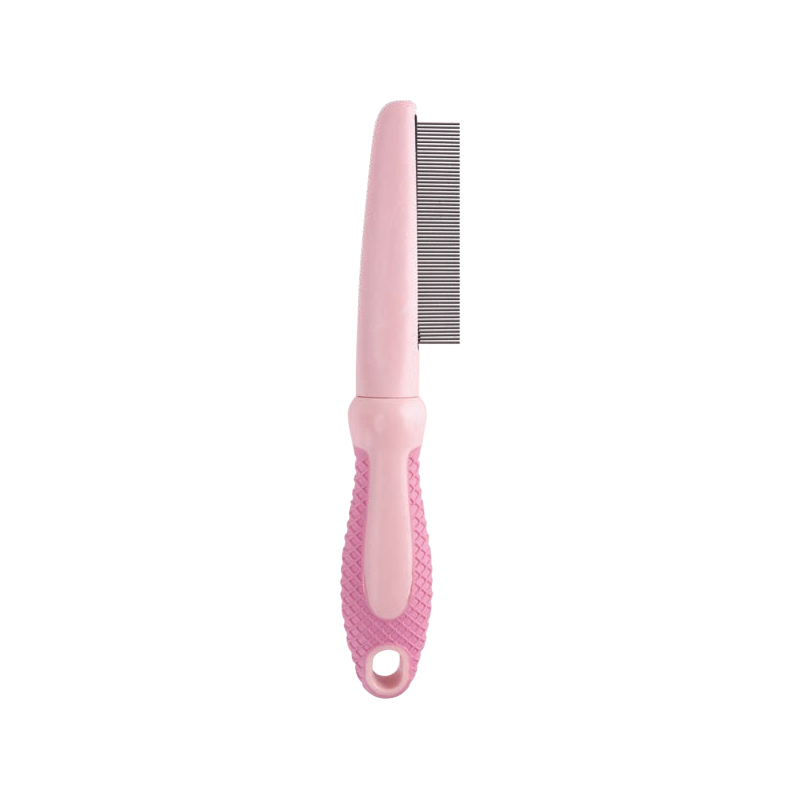What exactly is a Pet Grooming Comb — and why does it matter now?
What is a Pet Grooming Comb? Ask that question and you get a simple image: a hand passing a narrow tool through fur. But the reality is richer — a Pet Grooming Comb sits at the center of daily coat care, a precision instrument that removes loose hair, teases out knots, and acts as an early-warning system for parasites and skin issues. When used the right way it reduces discomfort for animals, shortens salon time for groomers, and makes at-home grooming a practical routine for owners.
Who Truly Needs a Pet Grooming Comb?
Long-Haired Companions (Yorkshires, Persians, Afghan Hounds): Their luxurious coats trap dirt easily and mat quickly, especially in humid conditions exacerbated by climate shifts. Daily combing isn't vanity; it's essential healthcare to prevent painful skin pulls and sores.
Thick/Double-Coated Breeds (German Shepherds, Huskies, Malamutes): These coats undergo intense seasonal shedding cycles ("blowing coat"), increasingly disrupted by erratic weather. A robust comb like Taizhou Opey's dual-sided undercoat rakes is vital for removing the dense, insulating underfur, preventing overheating in summer and ensuring proper insulation regrowth in winter.
Curly-Coated Wonders (Poodles, Bichons, Curly-Coated Retrievers): Tight curls easily form stubborn mats close to the skin, trapping moisture and bacteria. Regular, meticulous combing is the only defense against severe matting requiring shaving.
Short-Haired Pets & All Pets for Parasite Vigilance: Even sleek coats shed and gather debris. Combing removes dead hair effectively and provides the perfect opportunity for early flea detection using a fine-toothed comb – a growing concern as warmer temperatures expand flea habitats.
Pets with Sensitive Skin or Hot Spots: Here, combing around (never directly on) irritated areas is key. Gentle strokes maintain coat flow and skin ventilation without causing pain. Taizhou Opey designs combs with rounded, polished tips specifically for pets needing extra comfort care.
Which comb for which coat?
Step 1: Identify coat architecture
There are four broad types to consider: single short coat, double coat with dense underfur, long flowing coat, and curly or wiry coat. Each reacts differently to comb geometry.
Step 2: Match comb teeth to coat
Fine-toothed combs catch tiny loose hairs and are ideal for short coats and flea checks. Wider-spaced teeth slide through long and thick fur without pulling. A two-sided steel comb — one fine side, one wide side — is the most versatile daily tool for mixed coats.
Step 3: Consider materials and finish
Stainless steel teeth with rounded tips minimize skin abrasion and last longer when exposed to water and disinfectants. A rust-resistant spine and an ergonomic handle reduce wrist strain for frequent use.
Why Consistent Combing is Non-Negotiable Pet Care
The Multifaceted BenefitsRegular combing sessions offer far more than a tidy appearance; they are foundational to physical health and emotional bonding:
• Mat & Tangle Prevention: Proactive removal stops small knots from becoming painful, skin-tight mats that restrict movement, cause bruising, and harbor infection.
• Optimal Skin & Coat Health: Combing effectively lifts away dead hair, dander, pollen, and environmental pollutants trapped in the fur. Crucially, it massages the skin and distributes natural oils (sebum) from root to tip, creating a healthier, more resilient, and naturally lustrous coat. This natural barrier is increasingly important against environmental irritants.
• Early Health Detection: Combing sessions are invaluable check-ups. They allow owners to feel for unusual lumps, bumps, signs of parasites (fleas, ticks), redness, dryness, flaking, or hidden hot spots long before they become severe issues.
• Shedding & Hairball Management: Removing loose hair before it falls out significantly reduces household shedding. For cats, this directly minimizes the ingestion of hair during self-grooming, reducing the frequency and severity of hairballs.
• Stress Reduction & Bonding: Gentle, predictable grooming sessions build immense trust. For pets prone to anxiety exacerbated by environmental stressors (storms, heat), a calm combing ritual becomes a comforting constant. Using tools designed for comfort, like those from Taizhou Opey, enhances this positive experience.

Combing with Care: Navigating Sensitive Skin and Hot Spots
Pets experiencing skin sensitivity or active hot spots require special consideration during grooming:
• Location is Paramount: Avoid combing directly over hot spots or severely irritated skin. Focus gently on the surrounding areas to prevent matting buildup that could worsen the condition by trapping moisture or bacteria near the affected zone. Prioritize calm environments – consider a quiet room at home or a low-stress mobile grooming option.
How do you comb without causing pain or damage?
Step 1: Start at the extremities
Work from the paws and tail inward toward the spine, holding long fur close to the skin with your free hand to reduce tug. This tension-control technique prevents painful yanks.
Step 2: Use progressive tooth sizes
For thick mats, begin with a wide-tooth comb to open the tangle, then switch to a medium or fine-tooth comb to remove loose hair. For sensitive skin or hot spots, avoid the affected region and comb the surrounding area gently to keep the coat from matting.
Step 3: Work in short sessions and calm your pet
Frequent, gentle sessions are both better for coat health and for forming a positive grooming habit.
What role does a comb play in parasite and skin issue detection?
A fine-tooth flea comb is the first diagnostic tool in many households and clinics. Regular combing frequently surfaces tiny black flecks, tick attachments, or localized dermatitis before a problem requires medication or a clinic visit. Because fleas, ticks, and related bacterial risks have shown localized upticks in some regions recently, routine combing has become part of preventive pet care for many owners.
Which comb features are worth specifying if you're buying wholesale or manufacturing?
Technical specifications owners and retailers should ask for:
• Tooth material and tip finishing — stainless steel with blunted tips recommended for skin safety.
• Tooth spacing options — fine (for flea checks), medium (everyday grooming), widing minimal pressure. Stop immediately if your pet shows discomfort. Support the skin underneath the area you are combing near a hot spot to prevent pulling.
◦ Complementary Products: Use only hypoallergenic, fragrance-free shampoos and conditioners specifically formulated for sensitive skin during baths. Always pat dry gently; never rub irritated skin. Crucially, consult your veterinarian before grooming a pet with active skin issues to determine the underlying cause and appropriate care plan.
Taizhou Opey can leverage these signals by offering an entry-level eco line with recyclable packaging and a premium salon line with autoclavable components, enabling the same product family to address multiple channels.
How to pick a Pet Grooming Comb right now
1. Match tooth spacing to coat type (fine for short/flea inspection, wide for detangling).
2. Prefer stainless steel teeth with rounded tips.
3. Seek ergonomic, non-slip handles for frequent use.
4. Look for modular inserts or two-sided combs for versatility.
5. If you groom at home, pair a comb with short, calm grooming sessions and a reward system.
Integrating the Comb into Regular Grooming
RoutinesCombing is the cornerstone of a broader grooming strategy. Frequency depends heavily on individual factors:
• Coat Type & Length: Short coats (1-2 times/week), Medium coats (2-3 times/week), Long/Dense/Curly coats (Daily to every other day essential).
• Seasonal Shifts: Increase combing significantly during seasonal shedding periods (spring/fall), which can be prolonged or intensified by unusual weather patterns. Summer demands vigilance against mats from swimming or humidity; winter requires maintaining coat health against dry indoor air and potential moisture from snow/ice.
• Combing as Preparation: Always comb thoroughly before bathing. Bathing a matted coat makes mats tighter and harder to remove. Combing after bathing, while the coat is drying (but not fully dry), helps achieve a smooth, tangle-free finish.
How to groom pets with sensitive skin or hot spots without making things worse?
Start by asking whether the area is hot, weeping, or obviously painful. If so, do not comb that patch. Instead:
Step A: Stabilize the environment — choose a low-distraction spot with a soft surface and mild lighting.
Step B: Use the gentlest tools — soft-bristle brushes and a wide-toothed comb for adjacent areas.
Step C: Avoid topical irritants — use fragrance-free, hypoallergenic products only after vet approval.
The Comb as a Commitment to ResilienceIn a world where environmental factors increasingly impact pet health, mastering the use of the pet grooming comb transcends simple aesthetics. It's an active, daily commitment to your companion's comfort, health resilience, and early problem detection. Choosing the right comb – designed thoughtfully with the pet's comfort and the owner's ease of use in mind, like those developed by Taizhou Opey – transforms this essential task from a chore into a powerful act of care. It's the quiet, consistent practice that empowers pets to face environmental shifts with healthier skin, a more manageable coat, and a stronger bond with their human caregiver. Discover the tangible difference that thoughtful design makes in every stroke.
 English
English 中文简体
中文简体 русский
русский

